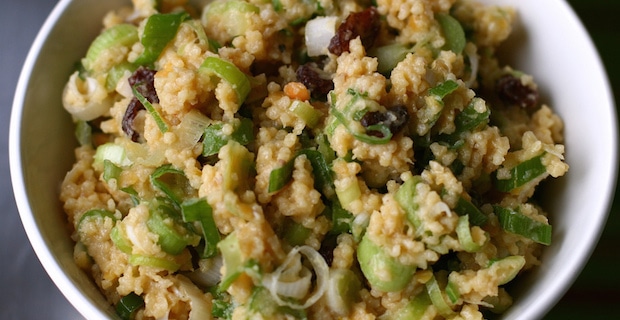
Grains are the seeds of their parent plants. The seed, or kernel, is made up of three parts: the bran, the endosperm and the germ. Each of these components all play a key role in your diet, containing valuable nutrients. Have fun baking, experimenting, and enjoying the wholesome nutrition with the following whole grains:
1. Amaranth: One cup of amaranth contains more protein than almost any other grain (28g per cup uncooked).
2. Barley: This chewy grain is great in soups or as a breakfast cereal and makes a great base for rice-pilafs, casseroles and marinated salads. When buying, look for pot barley. [Contains gluten.]
[Recipe] Turkey Breast with Barley-Cranberry Stuffing
3. Buckwheat: Add this grain to cakes and pancake mixes as it is rich in potassium and B vitamins.
4. Brown Rice: The most ancient and nutritionally balanced grain, rice is one of the easiest foods to digest and is completely gluten-free (all varieties). It is also high in B vitamins and vitamin E.
5. Bulgur: This grain is actually wheat that has been parboiled, dried, and cracked. [Contains gluten.]
6. Corn and Corn Meal: This is the only grain which contains vitamin A. Be sure to choose organic as most conventional corn is GMO.
7. Couscous: This is a cracked wheat grain. When buying, look for couscous that is unrefined. [Contains gluten.]
8. Kamut: (Pronounced "ka-moot"). A staple grain of the Pharaohs in Egypt 6,000 years ago, Kamut is a relative of durum wheat, has a sweet, nutty flavor and makes for great pasta. [Contains gluten.]
9. Millet: This grain is gluten-free and alkalizing when cooked. Serve the same way as rice.
10. Oats: High in silica, oats can help to keep your skin, nails and hair strong, shiny and healthy. [Does not inherently contain gluten, but frequently contaminated. Learn more about this here.]
11. Quinoa: (Pronounced "kee-no-a"). A light and delicate grain that is rich in protein. Quinoa can be substituted for rice in recipes.
Read more about quinoa recipes you'll love
12. Rye: This grain has a strong, hearty flavor and has low gluten content. [Contains gluten.]
13. Spelt: This member of the wheat family lowers cholesterol, stimulates immunity and can help blood to clot. [Contains gluten.]
14. Triticale: (Pronounced "tri-ti-cay-lee"). This high-protein grain can substitute for wheat in any recipe. [Contains gluten.]
15. Wheat: A good source of fiber and B-complex vitamins, this grain dates back to ancient Asia. Most breads, pasta and baked goods use wheat as their main ingredient. [Contains gluten.]
Read labels to ensure the product you are eating is made from the whole grain – it should be the first ingredient listed. For example: “whole grain spelt flour”, “whole oat flour” or “whole grain wheat”.
Image: Katrin Morenz










